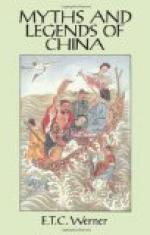The Three Causes
Connected with Taoism, but not exclusively associated with that religion, is the worship of the Three Causes, the deities presiding over three departments of physical nature, Heaven, earth, and water. They are known by various designations: San Kuan, ’the Three Agents’; San Yuean, ‘the Three Origins’; San Kuan Ta Ti, ’the Three Great Emperor Agents’; and T’ai Shang San Kuan, ’the Three Supreme Agents.’ This worship has passed through four chief phases, as follows:
The first comprises Heaven, earth, and water, T’ien, Ti, Shui, the sources of happiness, forgiveness of sins, and deliverance from evil respectively. Each of these is called King-emperor. Their names, written on labels and offered to Heaven (on a mountain), earth (by burial), and water (by immersion), are supposed to cure sickness. This idea dates from the Han dynasty, being first noted about A.D. 172.
The second, San Yuean dating from A.D. 407 under the Wei dynasty, identified the Three Agents with three dates of which they were respectively made the patrons. The year was divided into three unequal parts: the first to the seventh moon; the seventh to the tenth; and the tenth to the twelfth. Of these, the fifteenth day of the first, seventh, and tenth moons respectively became the three principal dates of these periods. Thus the Agent of Heaven became the principal patron of the first division, honoured on the fifteenth day of the first moon, and so on.
The third phase, San Kuan, resulted from the first two being found too complicated for popular favour. The San Kuan were the three sons of a man, Ch’en Tzu-ch’un, who was so handsome and intelligent that the three daughters of Lung Wang, the Dragon-king, fell in love with him and went to live with him. The eldest girl was the mother of the Superior Cause, the second of the Medium Cause, and the third of the Inferior Cause. All these were gifted with supernatural powers. Yuean-shih T’ien-tsun canonized them as the Three Great Emperor Agents of Heaven, earth, and water, governors of all beings, devils or gods, in the three regions of the universe. As in the first phase, the T’ien Kuan confers happiness, the Ti Kuan grants remission of sins, and the Shui Kuan delivers from evil or misfortune.
The fourth phase consisted simply in the substitution by the priests for the abstract or time-principles of the three great sovereigns of ancient times, Yao, Shun, and Yue. The literati, proud of the apotheosis of their ancient rulers, hastened to offer incense to them, and temples, San Yuean Kung, arose in very many parts of the Empire.




